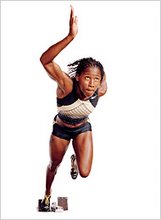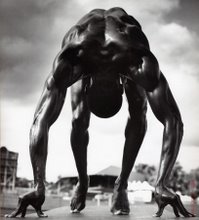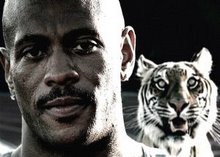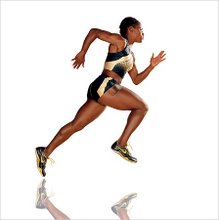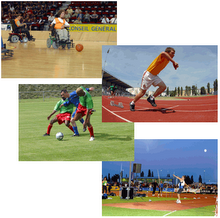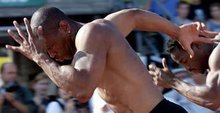
New York, USA – The Reebok Grand Prix, just two years old, has already seen world leaders, area records, and in 2006, a World record, when Meseret Defar ran an unexpected 14:24.53 for the women’s 5000m. In its third year, the meet, held in Icahn Stadium on Randall's Island, will again look for stellar early-season performances this Saturday (2) from top athletes, this time as the part of the IAAF World Athletics Tour 2007 and one of only two Grand Prix status meetings in the USA.
Dibaba to attack 5000m mark
While Meseret Defar's world mark last year took even meet organizers by surprise - most of the reporters on hand were in the interview room with the 100m winners while the record was run - Tirunesh Dibaba's arrival at the same track, four months after she lowered her own indoor 5000m mark, can only suggest one thing.
Dibaba has indicated that she will attempt to defend her 5000m and 10,000m World Championship double in Osaka, and in the shorter race Defar is chief among her opposition. If conditions allow, as they did in 2006, Dibaba may try to take the outdoor record from Defar and add it to her own collection.
Liu Xiang challenged
World 110m record holder Liu Xiang, whose 13.14 in Osaka was the 2007 world leader for only a few hours, will face the two men who have run 13.12 in 2007, Anwar Moore and David Payne. Liu Xiang ran in New York in 2005 as the new Olympic champion, losing to veteran Allen Johnson. He returns as the outright World record holder, but Moore and Payne are joined by Terrence Trammell and Aries Merrit, making four high class hurdlers who would love to score a win over Liu.
The women's 100m Hurdles includes Virginia Powell, the second-fastest hurdler this year, and Lolo Jones, the third, as well as 2003 World Champion Perdita Felicien.
Sprint battles on the schedule
World records aside, one of the top spectator attractions for this meet will be the sprints. New York's Jamaican population turns out to see their stars, just as they do at the Penn Relays in Philadelphia in April, and they have four good races to look forward to on Saturday.
Times were relatively slow in 2006, as the sprinters complained about the cool conditions which favoured Defar's distance record. However, should the warmer conditions which prevailed in 2005 return, fans may get to see just how fast the Icahn Stadium track really is.
In the men's 200m, Jamaica's mercurial Usain Bolt will challenge Wallace Spearmon, who last year became the third quickest man in history (19.65). Spearmon won this duel last year, and with a 19.91 two weeks ago in Carson he has signalled that he is already in top form. Bolt, the World Junior record holder, is also currently in form clocking 19.96 in Port of Spain last Sunday.
The women's 100m features the five fastest women of 2007, with Torri Edwards (10.90), Veronica Campbell (10.91), Me'Lisa Barber (10.95), Carmelita Jeter (11.05) and Marshavet Hooker (11.06) all scheduled to start. All five marks were set in Carson two weeks ago, and the sixth-fastest woman to date, Jamaica's Kerron Stewart, is in the 200m.
Stewart and LaShaunte'a Moore of the USA lead the half-lap field with the third and fourth fastest times this year, respectively.
Also joining the women's 100m field is reigning World champion Lauryn Williams. Allyson Felix, the 2005 World champion and current world season leader at 200m, will be running the 400m in New York.
The men's 100m doesn't have the world's fastest man, but it does have Tyson Gay, whose wind-assisted 9.79 in Carson is the fastest clock-stopper this year, albeit not the fastest legal mark. Gay, the sixth fastest man all-time at 100m (9.84) and fourth= at the 200m (19.68) will be joined on the line by World Indoior 60m champion Leonard Scott and fellow American Marcus Brunson. Olympic 200m champion Shawn Crawford is stepping down from 200m to join the 100m field as well.
Millrose rematch in men's Mile
Two more big names in New York are multiple Olympic medallist Bernard Lagat and Australian ace Craig "Buster" Mottram, the World 5000m bronze medallist. Lagat and Mottram duelled to the final lap in the Wanamaker Mile at this year's Millrose Games, and they will race that distance again in New York. Mottram, who was recently outrun in the Healthy Kidney 10K across the East River in Central Park, has his eye on the 5000m title in Osaka, and knows he'll need a miler's speed to get it. Lagat, long a runner-up at 1500m, wants gold in the shorter race.
Mottram and Lagat will be joined by two young Americans who wouldn't mind taking Lagat's place on the stand, Alan Webb and Chris Lukezic, as well as China's leading miler, Ming Gu.
Vaulters and middle distances
Current world leader Jennifer Stuczynski headlines the women's Pole Vault, with former World record holder Stacy Dragila now the challenger. Rising Chinese star Shuying Gao, this year's fifth-highest vaulter, will also jump in New York.
The men's vault also has 2007's highest vaulter, with World Indoor champion Brad Walker taking on Jeff Hartwig, Toby Stevenson and Nick Hysong, among others.
The men's 800m features two top-ranked two-lappers in Khadevis Robinson and Alex Kipchirchir; Diane Cummins leads the women's event.
 Yokhama, Japan - The 2007 Super-Meet will be held tomorrow, Sunday 30 September, and five Osaka World Championship gold medallists expected to compete in Yokhama’s annual meeting: Tyson Gay (USA) at 100m and 200m, Kerron Clement (USA) at 400m Hurdles,
Yokhama, Japan - The 2007 Super-Meet will be held tomorrow, Sunday 30 September, and five Osaka World Championship gold medallists expected to compete in Yokhama’s annual meeting: Tyson Gay (USA) at 100m and 200m, Kerron Clement (USA) at 400m Hurdles,



















.jpg)


